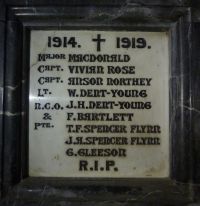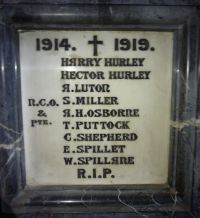Oldfield Park Junior School (Bath) WW1 Memorial Project
St John RC (Bath) WW1 Memorial



This memorial pieta statue is in the north transept.
This from Bath Chronicle and Weekly Gazette of Saturday 14th June 1919:
VICTORY IN DEATH
ST. JOHN'S (R.C.) WAR MEMORIAL
THE DEDICATION CEREMONY
The memorial commemorating the members of the congregation
of the Benedictine Church of St. John the Evangelist, South Parade, who
perished in the war was unveiled during Vespers on the evening of Whit-Sunday by
Monsignor A. S. Barnes. M.A. The special form of service used included the “De
Profundis” in memory of the fallen, the 13th Station the Cross,
"Jesus is taken down from the Cross," and the hymn “Stabat Mater."
Monsignor Barnes preached from John xiii., v. 1,
"Having loved His own who were in the world, he loved them unto the
end." Unto what end? he asked. Clearly to that end which was represented in
the sculpture that they just been blessing. That scene was seared on the memory
of St. John. It was a scene which he never forgot. There was nothing, he thought,
which more keenly appealed to mankind than the representation in Christian art of
the Mother and Child. How that conception made them realise the Love of God!
Mary herself seemed to give them this message, that in that poor little Babe
whom she held, God had gjven Himself to show that had reserved no power for
Himself at all. As they thought of such a presentment they might think of Mary as
"Our Lady of Hope" who had brought into the world the Infant Saviour,
who had done so much for all. But surely there was another picture less
familiar to us perhaps, but which was also a realisation of the love of God for
man. That was the picture which they found in their memorial: of Jesus taken
down from the Cross and laid once more in the arms of His Mother, as though he were
a little child. If we called the first picture "Our Lady of Hope,"
what name should give to this one? Surely, paradox though it might seem, we
might, call her "Our Lady of Victory—of Triumph, of Joy." For that second
picture denoted that God had come, God had fought, God had died, and the
victory had been won.
LOVE THE EXPLANATION OF SUFFERING
We suffered with Christ in order that we might have our
share in His work. Let us try to look at suffering in some such light as that. Though
the men in the trenches might not have thought out the matter thoroughly for
themselves, deep down in the bottom each man's heart there was probably the knowledge
that he was doing his duty, and that it was right for him to be there. For two
years he had held a chaplaincy in one of the largest military hospitals in the
country, where there were 2,000 beds for wounded men, and both there and in his
present post at the University of Oxford, where officers were coming back from
the war, he had realised the existence of a changed attitude towards religion.
Let them look on these bereavements and the apparently tragic close of a young life
in the light of eternity. They would then be able to view them in the right
light. Let them look upon these bereavements, not as if this life were
everything, but as if a boy had left school a term earlier than he would
otherwise have done. Let them think that it had pleased God to take His boy to
another life, a bigger and more spacious life. The moment we looked upon the
question in the light of eternity it would appear to us in a more glorious
light.
SALVATION UNTO THE UTTERMOST
Some deplored the death of their loved ones without the
benefit of the Sacraments, and we all admired those priests who had crept out
into "No Man's Land" to administer the Sacraments to the wounded
lying there, often at the risk of their own lives. But God was not bound by the
Sacraments. He could give without them what He could give through them. Doctors
and great men told us that some considerable period of time elapsed after
apparent death before the soul actually left the body. A revelation vouchsafed to
a member of his family who had lived some centuries earlier, and was an anchorite
of the Benedictine Order, supported this theory, for in a vision granted to her
Christ had said "In that last moment I show myself to them in so pleasurable
a way that I win their love for ever if possible." That pieta should
signify to them that God had conquered death and had won the victory, and that
love was His meaning.
The service of Benediction followed and at the conclusion of
service the Dead March in "Saul" was played.
THE MEMORIAL DESCRIBED
The subject of the memorial is the Virgin supporting the
body of the dead Christ. The group is carved in white stone taken from the old
Roman quarries at Seaton, Dorset. The treatment differs from the usual one, in which
the body of Christ rests entirely on the knees of His mother. The result of such
an arrangement may be seen in the famous "Pieta" by Michael Angelo in
Rome, where the body of Christ is that of a youth. In St. John's "Pieta"
the lower part of the body rests on the ground. The black marble of the pedestal is
from the Old Bench Quarry on Lord Clifford's estate at Chudleigh. The grey
marble, with the inscription. "A voice was heard in Ramah. Rachel mourning
her sons." (Matt. 2 v. 18) is pure Carrara marble. The centre panels are in
white statuary marble. The latter bear the names of those commemorated; the
former has the Cross and palm and myrtle branches, the emblems of sacrifice and
victory. The whole is the work of Messrs. Wall of Cheltenham. The sculptor, Mr.
W.H. Best has executed most of the carving at Downside Abbey including the
three fine monumental figures of bishops buried there.
The inscription is:
"A voice was heard in Rama: Rachel mourning her son" Matthew ch2 v18
And the side panels bear the names:
| Major MacDonald Captain Vivian Rose Captain Anson Northey Lieutenant W. Dent-Young NCO & Private: J. H. Dent-Young F. Bartlett T. F. Spencer-Flynn J. A. Spencer-Flynn G. Gleeson R.I.P. | NCO & Private: Harry Hurley Hector Hurley A. Luton S. Miller A. H. Osborne T. Puttock C. Shepherd E. Spillet W. Spillane R.I.P. |